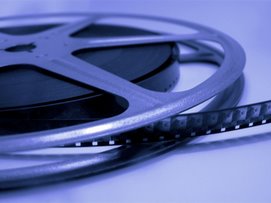
The Da Vinci Code; Mystery thriller, USA, 2006; D: Ron Howard, S: Tom Hanks, Audrey Tautou, Ian McKellen, Paul Bettany, Jean Reno, Alfred Molina, Jürgen Prochnow
Curator Jacques Sauniere is killed in the Louvre in Paris by Silas. Later on, French police captain Fache summons US symbologist Robert Langdon to the crime scene because Jacques created cryptic clues before his death. Robert deciphers it but Sophie, a police officer, helps him get away since Fache thinks he is the murderer. On their way, Robert and Sophie discover the murder is connected to Priory the Sion and the search for the Holy Grail. They hide at Leigh's place and then go to London. After many complications, it is discovered that Leigh ordered the murder to find the keystone for the Grail. Robert actually discovers the truth: Jesus and Mary Magdalene were married and had children, while Sophie is the last descendant of them.
The most hyped film of 2006, "The Da Vinci Code" in the long run ultimately fails to live up to the viewers' expectations: it has a stimulative, philosophical premise about religion, but it gets drowned in a silly action thriller. Ron Howard was hardly ever a real master director, and thus it comes as no surprise that he didn't manage to make a more artistic achievement out of the already criticized novel by Dan Brown which some critics have dismissed as a populists example of "fast food" literature. The exposition is the best, where professor Robert Langdon (good Tom Hanks) holds a lecture about symbols, among others revealing how the swastika sign is infamous in the West, but normal among the Indian religion of Jainism, showing how some things are not always what they seem. It goes hand in hand with the theme of the story where the modern Christian religion may be based on distortion of the church, namely that Jesus Christ and Mary Magdalene may have been married and had children, pointing out to the gnostic Gospel of Philip.Some of the philosophical dialogues between Robert and Leigh about that manage to ignite some spark, yet the majority of the elements in the film were handled too superficially, while some clues that supposedly "lead" to other clues and mysteries are so far fetched that not even children would take them seriously. For instance, before the wounded Jacques died at the beginning, he conveniently had just enough time to use his own blood and black light ink to write cryptic messages around the louvre, first on the floor, then leading to the wall on the other side, where Leonardo Da Vinci's "Mona Lisa" is placed, and then leading to other clues and so on and on. Wouldn't it have been so much more simpler if he just wrote what he wanted to say? When Robert arrives on the crime scene, he manages to look at his random sentences and conclude the anagram "Leonardo Da Vinci" out of it in just 15 seconds. And what if that wasn't an anagram at all? Equally over-the-top is the scene where Leigh manages to smuggle Robert and Sophie in his airplane to London, pass the police. How? It couldn't be more stupid: just 2 seconds before the police showed up, the two of them ran out of the arriving plane and managed to hide in a car that was conveniently parked there. Some of those silly moments almost seem like a parody. "The Da Vinci Code" is a 'guilty pleasure', yet even such a minimum of philosophical premise in a big budget film deserves modest praise.
Grade:+




No comments:
Post a Comment